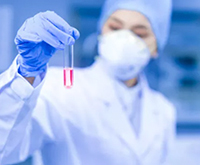Anti-human Mullerian Hormone (AMH)
Anti-Müllerian hormone, also known as Müllerian-inhibiting hormone, is a glycoprotein hormone structurally related to inhibin and activin from the transforming growth factor-beta superfamily.
The critical roles of AMH are in growth differentiation and folliculogenesis. For adult women, AMH inhibits the rise of the primordial follicle and sinus follicle development, prevents premature ovarian follicles depletion.
AMH has many obvious advantages in the evaluation of ovarian reserve. It is the most accurate biomarker of ovarian aging and can reflect the decline of ovarian reserve with age earlier, and its level is not affected by the menstrual cycle, hormonal contraceptives, and pregnancy.
Anti-human Mullerian Hormone (AMH) Products
| Antibody | Application |
| Mouse Anti-human AMH mAb | For immunodiagnostic: ELISA, LFA, CLIA |
| Humanized Anti-human AMH mAb |
Anti Mullerian Hormone
Mature hormones are dimeric glycoproteins that connect two identical 72 KD monomers by disulfide bonds and belong to the transforming growth factor-β (TGF-β) superfamily. AMH mainly exerts its biological effects through AMH receptor II.
Female fertility is closely related to ovarian reserve and various reproductive hormones in the body. Insufficient ovarian reserve can lead to premature aging in women, long menstrual cycles, aggravated cardiovascular problems, and even lead to symptoms such as menopause, menopause, and infertility.
AMH Test
In evaluating ovarian reserve, anti-Mullerian hormone (AMH) testing can make up for the insufficiency of traditional hormone testing and can quickly and effectively know the ovarian reserve level.
During embryonic development, AMH regulates the differentiation and development of the reproductive tract and is essential for sex differentiation; postnatally, AMH regulates Leydig cell function in males; in adult females, AMH inhibits the recruitment of primordial follicles and antral follicles development and prevent premature follicle depletion.
Compared with other traditional biological indicators, AMH has many apparent advantages in evaluating ovarian reserve and is the most accurate biomarker of ovarian aging. AMH reflects the declining trend of ovarian reserve with age earlier than FSH, estradiol (E2), inhibin B (inhB), and antral follicle count (AFC), and its levels are not affected by the menstrual cycle, hormonal contraceptives, and the effects of pregnancy.
Although some studies have shown an inevitable fluctuation in AMH during women's menstrual cycle, especially young women, the change is much smaller than other sex hormones. Therefore, the existing guidelines mainly support the detection of AMH at any time in the menstrual cycle.


















